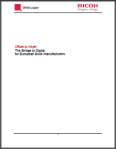
Rich Lloyd – Global Offset to Digital Offerings Manager, Ricoh
We all know short runs are here to stay, so the question is how to make more money out of short run production print while providing the same level of service that your customers come to expect. Whether you’ve been producing digital books for years, or you want to expand your print on demand strategy, these tips can help you.
1. Know your current workflow costs. Do you really have a firm grasp on what your current costs are? Wouldn’t it make sense to run through that analysis so you have a baseline? It doesn’t matter if you’re using manual or automated processes. You want to know where you are today, so when you change part of your overall workflow, you can figure out the operational impact and ROI. The more you do this, the more you’ll understand your cost variables and how to manage them.
2. Evaluate your short run publishing output. What are you printing now and where do you want to take your business? What percentage of your business is conventional versus digital? Figure out which jobs cost you the least and the most to produce. Create a growth plan based on current capabilities, your expertise, market opportunities and so on. The most cost-effective digital print solution lets you diversify in the areas where you want to expand but also streamlines the production of day-to-day work.
3. Remove as many human touch points as possible. Labour is costly, and so is human error. You need to be more competitive so you HAVE to be as efficient as possible. Automate as many steps and processes as you can. You may not be able to automate everything right away, but maybe look at a phased approach. Look for modular, open workflow solutions that give you add-on possibilities, and let you plug in third-party software and even your own systems if you want…leverage those investments that you’ve already made in your business.
4. Go beyond on demand book printing. Books may be a steady base of business, but diversifying can be a smart move. Some book printers are looking at critical communications, which are applications that must be delivered to a specific person: insurance explanations of benefits, prospectuses, voting ballots and so on—and often regulatory compliance is involved. Every piece needs to be tracked so you can confirm every piece is printed accurately. Automating the reprint process is essential. This type of work can be very profitable if you’re set up to do it right. The key is a workflow that can tackle a wide range of different applications.
5. Invest in software that saves money immediately. Always be on the lookout for automation tools that you can put to good use right away. Software that connects your print workflow to other parts of your business is critical to future growth. Self publishing has taken off – have you evaluated workflow solutions that can allow you to play in that market as well.
6. Look into colour management and optimisation. Considering the cost pressures from publishers, if you are doing full colour work, colour management and optimization can be keys to improving overall profitability whether it’s conventional or digital output.
There are lots of ways to increase short run publishing profitability, but they need to make sense for your business.
To find out more, read our White Paper: Offset to Inkjet – The Bridge to Digital for European Book Manufacturers
This is available from Ricoh Business Driver or, if you are not a member, request it here.


You must be logged in to post a comment.